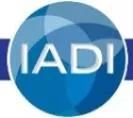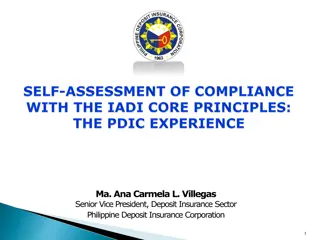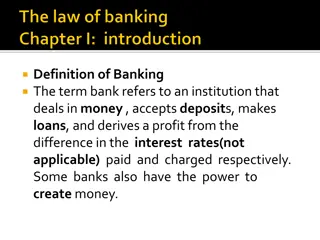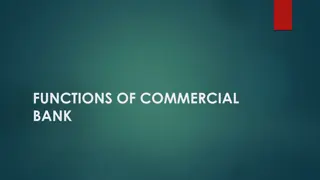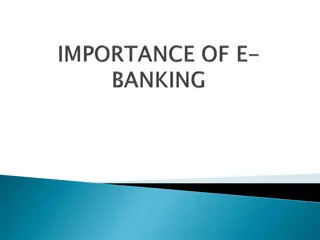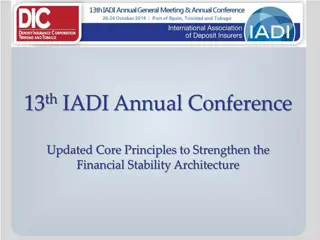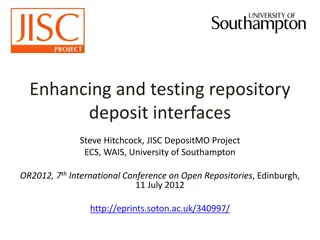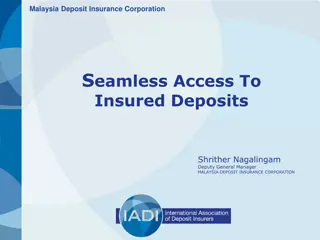Deposit Insurance Systems: Building Confidence and Stability in Banking
This presentation for New Zealand Treasury and RBNZ staff by David Walker focuses on the importance of deposit insurance systems worldwide. It covers the rationale behind deposit insurance, IADI's core principles, lessons learned from the financial crisis, and new challenges in the field. The advantages and disadvantages of deposit insurance, including the need for preconditions and considerations of moral hazard, are discussed. The presentation emphasizes the role of deposit insurance in protecting depositors, ensuring financial stability, and providing a mechanism for orderly bank resolution.
Download Presentation

Please find below an Image/Link to download the presentation.
The content on the website is provided AS IS for your information and personal use only. It may not be sold, licensed, or shared on other websites without obtaining consent from the author. Download presentation by click this link. If you encounter any issues during the download, it is possible that the publisher has removed the file from their server.
E N D
Presentation Transcript
Presentation to New Zealand Treasury and RBNZ Staff Wellington: 28-29 January 2019 David Walker, Secretary General IADI David.Walker@iadi.org
Presentation outline I. Background and rationale for deposit insurance II. IADI and deposit insurance systems around the world III. IADI Core Principles for Effective Deposit Insurance Systems IV. The financial crisis, lessons learned and new challenges in deposit insurance
I. Background and Rational for Deposit Insurance
Deposit insurance is a system established to protect depositors against the loss of their insured deposits in the event that a bank is unable to meet its obligations to the depositors. Financial Consumer Protection To protect unsophisticated, retail and/or small-scale depositors in case of a bank failure. Confidence and Stability Depositors are far less likely to run on banks in the event of a failure Advantages of Deposit Insurance Systems (DIS) More orderly resolution Provides for the orderly closure/resolution of banks and mechanism(s) to recover costs from the industry. Greater Certainty Limits 100% implicit guarantees common in many jurisdictions with no explicit deposit insurance.
Needs preconditions Preconditions for effective DIS include sound legal frameworks, supervisory, regulatory and accounting systems Systemic crises Although DIS can reduce incidence of retail runs it cannot by itself deal with a broad based systemic banking crisis Moral Hazard A DIS (as with other elements of the safety-net) contributes to stability. However, if poorly designed, it may increase risks i.e. moral hazard.
Advantages Disadvantages Relies entirely on markets Greater propensity for bank runs and govt. bailouts Reliance on Market Discipline Depositors have a greater chance of recovering losses Doesn t provide a mechanism to reimburse depositors quickly Depositor Preference Banks invest in risk free assets only Major restructuring of banking system required Narrow Banks Very strong incentive for investors & governing minds to control risk Discourages investment and directorships in banks Governance Incentives Provides for more market discipline Not all banks can participate Subordinated Debt
Mitigating Moral Hazard and Preconditions A well-designed financial safety-net contributes to the stability of the financial system. However, if poorly designed, it may increase risks, notably moral hazard. Moral hazard arises when parties have incentives to accept more risk because the costs are borne, in whole or in part, by others. In the context of deposit insurance, protecting depositors from the threat of loss insulates them from the consequences of unsafe and unsound bank practices, and can lead to greater risk-taking by banks. Deposit insurance, like any insurance system, must be designed to mitigate the impact of moral hazard on the behaviour of shareholders, bank management and depositors. Such mitigation is a function of the overall design of the system. Moral hazard is also mitigated by other safety-net participants.
More specifically: Key design features of the deposit insurance system aimed at mitigating moral hazard include: limited coverage levels and scope; differential premiums; and timely intervention and resolution by the deposit insurer or other participants. The financial safety-net creates and supports appropriate incentives to mitigate moral hazard through several mechanisms, including meeting important pre-conditions such as: the promotion of good corporate governance and sound risk management at individual banks; holding parties at fault responsible for losses; effective market discipline; and the enforcement of strong prudential regulation, supervision, resolution, and laws and regulations. The assessment of the extent to which moral hazard affects a deposit insurance system is based on an evaluation of the effectiveness of supervision, legal framework, and the intervention and resolution regimes.
II. International Association of Deposit Insurance (IADI) and Deposit Insurance around the World
Mission To contribute to the enhancement of deposit insurance system effectiveness by promoting guidance and international cooperation History Established in Basel in 2002 with 25 Founding Members Membership in 2018 83 Members, 10 Associates and 14 Partners Key Advancements IADI Core Principles for Effective Deposit Insurance Systems (CPs) issued in 2009 and revised in 2014 CPs have been incorporated into IMF/WB FSAPs and FSB Peer Reviews CP Handbook for Assessors published in 2016 Research & Guidance Research and guidance under development in areas such as: funding; financial inclusion, crisis management and asset recoveries IADI Biennial Research Conference in Basel May 2019 IADI Annual survey and database Training & Capacity Building Global/Regional conferences, seminars and technical workshops Joint FSI-IADI conferences and policy implementation meetings Website and on-line tutorials
Total 107 110 Partner 14 100 Associate 10 90 80 70 Member 83 60 50 79 83 80 79 40 72 65 63 62 30 54 52 48 46 42 20 35 34 26 25 10 0 Member Associate Partner Total
Deposit Insurance Systems around the World 2018 Survey Results IADI s 2018 global survey of deposit insurance and financial safety net frameworks received responses from 135 deposit insurers. Key highlights are: Governance and mandates of Deposit Insurers (DIs) The majority (75%) of DIs are legislated and administered by the public sector, although around 25% are privately administered. Three quarters of DIs are legally independent entities and remainder incorporated in the central bank or supervisory authority. Approximately 30% of DIs are assigned a pay box mandate focusing only on payouts. Approximately 40% of DIs have a pay box plus mandate, which typically include resolution functions (e.g. financial support and purchase and assumption powers). About 30% function as loss- or risk-minimisers acting as resolution authorities and in some cases conducting supervision.
More pay box plus and loss minimisers Tendency for DIs to play a greater role in resolution
2% 3% Middle East & North Africa 3 7 12% 12% 5 1 Eurasia 18% 17% 3 2 Africa 17% 3 1 Caribbean 40% 4 4 6 North America 2 8 5 Latin America 51% 9 5 3 4 Asia & Pacipic 30% 18 18 9 1 3 Europe 2008 2008 2017 2016 Pay-box Pay-box Plus Loss Minimiser Others Risk Minimiser
Membership and coverage Membership is mandatory for institutions in almost all jurisdictions, with banks being the dominant institutions. Coverage limits range from below 1,000 USD to still a few systems with blanket guarantees. Average level of Coverage was around 75,000 USD per depositor per institution (median around 54,482 USD) and has risen substantially over the last ten years. Funding Nearly 90% of DIS are funded by ex ante contributions. Of remaining jurisdictions relying on ex post funding, a number are in the process of implementing an ex ante funding. An increasing number of ex ante funded DIS have the authority under certain conditions to raise additional ex post contributions.
Average Coverage Limit Coverage Ratio (%) (%) 75,000 93.3 92.8 90.6 100 (in USD) 87.3 Median 54,482 80 60 46.3 43.5 40 20 0 by value per account per depositor 2009 2017 8 7 2014 2015 92.1% of deposit insurers have a statutory coverage limit whereas 7.9% of deposit insurers provide full (blanket) coverage Average coverage limit up sharply from 2009 to 2017 Estimated 93.3% of individual depositors are covered by their current DIS (Source: IADI Annual Survey 2009~2017)
Coverage proportions (% of # Depositor accounts fully protected) and (% of Value of Deposits fully covered) Issue of appropriate coverage levels best practice specified in CPs. Note: Asia-Pacific (APRC), Africa (ARC), Caribbean (CRC), Eurasia (EARC), Europe (ERC), Latin America (LARC), Middle-East (MENA), North America (RCNA)
Nearly 50% of DIs levy premiums on a flat rate basis; higher proportion of loss and risk minimisers charge premiums on risk-adjusted basis.
Depositor Payout and other Resolution Frameworks Some form of special resolution regime for banks exists in around three quarters of jurisdictions. Depositor payout and liquidation are the most common resolution tools. Next most common are purchase and assumption (P&A), bridge bank and open bank assistance tools. 33% of DIs have the authority to act as either receiver/liquidator, conservator/administrator or both. Payout time frames are being reduced -- but 7-day payout a challenge for many systems.
< DIA Access to Records > < Payment Methods > Transfer through P&A Agreement (33%) ATM or Cash (45%) 12% 10% Electronic Transfer (49%) Serving Bank (27%) Check (44%) 38% 41% Interim Payment (21%) Other (23%) Prior After Anytime Etc Various payment methods are available for reimbursing depositors. * Others: stored value card, mobile banking, prescribed account etc. More than half of DIAs are given access to an institution's financial and depositor s records prior to bank failure.
On an average, around 50% of DIAs are able to pay out in 7 days; risk minimisers more compliant; Europe and Asia more compliant Compliant jurisdictions can share their experience and provide TA to other jurisdictions
III. IADI Core Principles for Effective Deposit Insurance Systems
IADI Core Principles Core Principles for Effective Deposit Insurance Systems were approved by IADI and the BCBS in June 2009 and first Methodology completed in December 2010. IADI revised Core Principles (CP) completed and endorsed by the FSB in November 2014. Handbook completed in 2016. An assessment of compliance with the CPs is a useful tool for jurisdictions that are implementing, reviewing or actively reforming a DIS. Key objectives: 1) Improve the effectiveness of deposit insurance systems (DIS) in protecting depositors and contributing to financial stability... 2) ensure the CPs are adaptable to a wide range of country circumstances, settings and structures, and 3) mitigate moral hazard.
Key Characteristics 16 Core Principles 1. Public policy objectives 2. Mandate and powers 3. Governance 4. Relationships 5. Cross-border issues 6. Crisis management 7. Membership 8. Coverage 9. Sources and uses of funds 10. Public awareness 11. Legal protection 12. Dealing with parties at fault 13. Early detection and intervention 14. Failure resolution 15. Reimbursing depositors 16. Recoveries Developed in 2009 and revised in 2014. Incorporates best practices of deposit insurers and views of organizations such as the BIS, IMF, World Bank and European Forum of Deposit Insurers. Reflects lessons learned in past financial crises. Are being utilized in deposit insurer self-assessments, IMF-WB FSAPs and FSB peer reviews.
CPs strengthened in 2014/16 to promote more credible deposit insurance systems and to better integrate with other reforms (e.g. FSB Key Attributes). More Prescriptive 16 Core Principles General Mandatory ex-ante funding 7-working day payout target Sufficient coverage Strengthening Governance Frameworks Methodology: 96 Essential Criteria Enhancing operational independence Improving accountability New Crisis Management Principle Handbook: How To Guidebook Emphasise contingency planning and coordinating framework Specific More Safeguards On use of DI funding in resolution Enhanced info. sharing/co-ordination
IADI Core Principles more detail CP1. Public Policy Objectives Clearly defined and formally specified emphasizing depositor protection and contributing to financial stability. Review of the extent to which a deposit insurance system meets policy objectives conducted on a regular basis. CP2/3. Mandates, Powers and Governance Recognizes deposit insurer mandates vary from paybox to risk minimizers . Mandate clarifies roles and responsibilities of deposit insurer and is aligned with the mandates of the other safety-net participants. Deposit insurer is operationally independent, accountable and transparent. Powers support mandate.
CP4. Relationships with safety-net players Formal ongoing information sharing and coordination in place among deposit insurers and other safety-net participants.Rules ensure confidentiality. CP5 . Cross-border Issues Where there is a material presence of foreign banks in a jurisdiction formal information sharing coordination arrangements in place among deposit insurers. CP6. Crisis Preparedness and Management Deposit insurer should have effective contingency planning/crisis management policies to ensure it is able to effectively respond to bank failures. Deposit insurer a member of institutional framework for coordination involving system-wide crisis preparedness and management. Deposit insurer participates in the development of pre / post crisis management communication plans involving all safetey-net participants.
CP7/8. Membership and Coverage Membership compulsory for all banks. Vast majority of individual depositors to be covered but majority of the value of deposits exposed to market discipline. CP9. Funding Banks pay for deposit insurance. Deposit insurer must have ex-ante funding and assured access to emergency liquidity. Sound fund investment and management needs to be in place. Deposit insurer must authorize any use of its funds by other safety-net participants. CP10. Public Awareness The public should be informed on an ongoing basis about the benefits and limitations of the deposit insurance system. The deposit insurer is responsible for promoting public awareness about the deposit insurance system.
CP11/12. Legal issues The deposit insurer and all those working on its behalf are protected from liability arising from actions taken in good faith. CP13. Early detection and timely intervention The deposit insurer is part of the framework within the financial safety net that provides for the early detection of, and timely intervention in, troubled banks. The framework provides for intervention before non-viability. CP14. Failure resolution An effective failure resolution regime should enable the deposit insurer to provide for the protection of depositors and contribute to financial stability. Legal framework includes special resolution regime. Resolution regimes follow FSB Key Attributes key features
CP15. Reimbursing depositors Majority of insured depositors to be reimbursed within seven working days utilizing a variety of reimbursement options. Provisions to be made for making advance, interim or partial payments. Access to depositor records at all times; authority to undertake advance or preparatory exams. Scenario planning and simulations mandated. CP16. Recoveries The deposit insurer should by law have the right to recover its claims in accordance with the statutory creditor hierarchy. Management and disposition of the assets of failed banks is guided by commercial and economic considerations.
Interaction of CPs with other Standards Basel III and TLAC New capital, liquidity and stress testing requirements. Total Loss-absorbency Capacity (TLAC) established. Link between Liquidity Coverage Ratio (run-off rates) and IADI Core Principles compliance. BCBS Core Principles Basel Committee on Banking Supervision (BCBS) Core Principles for Effective Banking Supervision (BCPs). IADI CP 13 on early detection and timely intervention integrated with BCPs. Financial Stability Board (FSB) Key Attributes Key Attributes introduce new resolution tools such as bail-in and recovery and resolution planning. Emphasize high level information sharing within jurisdictions and in cross- border situations (e.g. Crisis Management Groups). IADI CPs closely aligned with Key Attributes (e.g. CP6,9 and 14).
Assessing the Core Principles An assessment of compliance with the Core Principles is a useful tool for jurisdictions that are implementing, reviewing or actively reforming a DIS. The assessment should identify strengths and weaknesses in the existing DIS, and form a basis for improvement or remedial measures by the deposit insurer and policymakers. An assessment should focus on the DIS and its relationship to the financial safety-net functions which support it. The methodology can be used in multiple contexts: > as part of the IMF and World Bank FSAP reviews; > self-assessments conducted by a DI including the IADI Standards Assessment and Reporting Program (SATAP); > as a basis for providing bi-lateral or multi-lateral technical assistance; > use by private third parties such as consulting firms hired to conduct assessments; and > peer reviews and thematic assessments conducted by the FSB.
Compliance Assessment Process CORE PRINCIPLES Compliance Assessment Compliant Largely Compliant Materially Non-Compliant Non-Compliant Not Applicable Essential Criteria Assessment Rating Essential criteria met w/o any significant deficiencies Only minor shortcomings; authority able to and intends to achieve full compliance Corrective Action Plan Severe shortcomings/ practical implementation weak Implementation Plan And Strategy No substantive implementation
(Jurisdictions carried out a formal compliance assessment) North America Eurasia* 1 2 9 Europe* Middle-East & North Africa 1 Asia- Pacific 2 7 Caribbean Africa 2 Latin America 5 Worldwide, 29 jurisdictions had either conducted assessments of their compliance with the IADI Core Principles (or had undergone FSAPs) by year-end 2018
Compliant Materially Non-compliant N/A Largely Compliant Non-compliant (Number of jurisdictions with the assessment result) *Based on 2014/09 CPs 1. Public Policy Objectives (PPOs) 10. Transitioning from Blanket Guarantee 2. Mitigating Moral Hazard 11. Funding 3. Mandate 12. Public Awareness 4. Powers 13. Legal Protection 14. Dealing with Parties at Fault 5. Governance 15. Early Detection, Timely Intervention & Resolution 6. Relationship with Other Safety Net Participants 16. Effective Resolution Processes 7. Cross-border Issues 17. Reimbursing Depositors 8. Compulsory Membership 18. Recoveries 9. Coverage 0 5 10 15 20 0 5 10 15 20
IV. Financial Crisis, lessons learned and new challenges
I. The financial crisis and deposit insurance The global financial crisis of 2007/8 showed that deposit The global financial crisis of 2007/8 showed that deposit insurance is a critical element of the financial safety insurance is a critical element of the financial safety- -net in promoting stability promoting stability. net in Different jurisdictions used different responses to protect Different jurisdictions used different responses to protect depositors depositors -- -- depending on crisis impacts and robustness of depending on crisis impacts and robustness of pre pre- -existing arrangements: existing arrangements: Some jurisdictions required little or no direct changes in deposit insurance arrangements (e.g. Indonesia, Japan, Korea, Canada); Others needed to significantly enhance their systems (e.g. Australia and UK); and While others with existing systems were forced to temporarily adopt blanket guarantees (e.g. Ireland, Hong Kong SAR, Malaysia and Singapore) due to regional and other factors.
Greater convergence in practices and key design features 1) Increases in coverage limits Less emphasis on moral hazard control through low coverage, elimination of coinsurance. 2) Expansion in mandates/powers Increase in pay-box plus and loss-minimizer systems. Most pronounced in Europe, Middle-East and Africa. Increase in number of deposit insurer with systemic bank resolution roles. > (e.g. FDIC-USA, CDIC-Canada, MDIC-Malaysia, IPAB-Mexico, NDIC-Nigeria, BGF-Poland, KDIC-Korea, KDIC-Kenya).
3) Increased emphasis on faster payout speeds 30-day (and sometimes longer) standard no longer acceptable. 4) Enhancements in information sharing and coordination More formal arrangements developed for domestic and cross- border arrangements. New focus on contingency planning and crisis management. 5) More robust funding arrangements Shift towards increased use of ex-ante funding and differential premium systems. Quest for more effective sources of back-up funding (liquidity). Establishment of specific resolution funds in many jurisdictions.
II. Getting ready for the next crisis key challenges for deposit insurers and regulators 1) Shifting from standards development to implenetation (e.g. IADI CPs, FSB Key Attributes, Basel III). a) Measuring compliance. b) Assessing effectiveness of reforms to-date. 2) Overcoming resisitance to reforms. a) Memories of the financial crisis are receding and reform fatigue is emerging. b) Banking industry pushing back on reforms (e.g. Dodd-Frank in the United States, Basel III in Europe). 3) Funding: Use of ex-ante funding more widespread but: a) Fund adequacy an issue b) Access to emergency liquidity borrowing problematic in many jurisdictions; and c) 1 in 3 deposit insurers have no target for their fund.
4)Resolution challenges: a) Achieving 7-day payout. b) Integrating new tools such as purchase and assumption and bridge- bank powers. c) Special challanges with bail-in: Building up bail-inable liability stacks takes time; Treatment of insured and uninsured depositors needs to be clarrified; Funding contributions and sources of liquidity need to be considered; Mitigating contagion during bail-in must be addressed; and Limited and uneven expereince (e.g. Cyprus, Italian banks, Bank Popular) has reduced support for bail-in. d) Systemic bank resolution roles for deposit insurers with loss/risk minimizing manadates on the rise (8 systems now). Developing resolution plans, crisis management groups and cross-border corrdination agreements. Funding in resolution. Integrating core deposit insurance functions with Systemic Bank Resolution.
5) Powers: Assured legal access by the deposit insurer to depositor information on an ongoing basis still not widespread. 6) Contingency planning and crisis preparedness: Many insurers still not included in system-wide crisis preparedness and planning frameworks. 7) Evaluating effectiveness of reforms to-date uneven. Compliance assessment? Measuring credibility? 8) Innovation: Financial innovation (e.g. FINTECH) impacts: Payment systems => lending => funding => Deposit taking? > > Crowdfunding Insured deposit-taking (e.g. mobile money, MPESA)
Special FINTECH banks (e.g. how to regulate and protect depositors?) 9) Shadow banks: Competitor to deposit-taking institutions? Is the presence of deposit insurance contributing to the rise of shadow banks? 10)Financial stability architecture support for deposit insurance: Basel III process (level and quality of capital has increased). Enhancements to supervisory frameworks emphasizing risk- based supervision, internal governance and risk management.
Promoting deposit insurance system compliance with the Core Principles Developing more formalized compliance assessment framework to identify gaps. Expanding the roster of IADI experts qualified to conduct assessments and support SATAP. Enhancing collaboration with the BIS, IMF, World Bank, FSB and others in utilizing the CPs. 01 02 Advancing deposit insurance research and policy development Identification and monitoring of global trends in deposit insurance. Development of research and policy positions to support deposit insurer interests. Enhance IADI s participation and influence in international forums. Providing members with technical support to modernize and upgrade their systems 03 Enhancing processes to identify member needs for technical support and capacity building and match with providers of assistance. Customizing technical assistance programs to meet member needs.
Looking ahead for deposit insurers Support Core Principle (CP) implementation through assessment reviews/identifying gaps and training. Work with the BIS, IMF, WB and FSB to incorporate CPs in FSAPs, technical assistance & peer reviews. Support implementation of FSB Key Attributes and adapting to new resolution regime. Review/recalibrate deposit insurance research & guidance to support CP compliance i.e. crisis preparedness and management guidance.
David Walker Secretary General International Association of Deposit Insurers c/o Bank for International Settlements Centralbahnplatz 2, CH 4002 Basel, Switzerland E-mail: David.Walker@iadi.org 15




